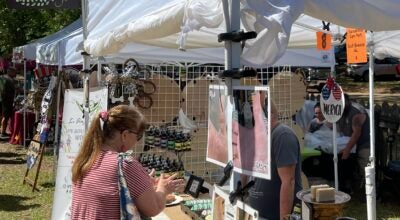UAB Wilcox study should answer hookworm outbreak question in Lowndes and other Black Belt Counties
Published 12:38 pm Tuesday, November 27, 2018
|
Getting your Trinity Audio player ready...
|
By Fred Guarino
The Lowndes Signal
The question of whether there is actually a hookworm outbreak in Lowndes and other counties of the Alabama Black Belt could soon be answered as the result of a study to be done in Wilcox County by the University of Alabama at Birmingham (UAB).
Lowndes County became the subject of national, if not worldwide attention, as the result of a study that showed Lowndes County residents tested positive for having low levels of hookworm. That was a study the Alabama Department of Health found flawed and disputed.
Also, In December 2017, the UN Special Rapporteur Phillip Alston noted the “cesspools of sewage” and “broken or non-existent septic systems” plaguing African American communities in the Lowndes County area and contrasted that condition with well-maintained buildings and sewer systems in cities where most white people lived.
The Alabama Department of Public Health and the Lowndes County Health Department are also currently facing a federal civil rights complaint that alleges both agencies discriminated against African American residents of Lowndes County.
Catherine Flowers, founder of the Alabama Center for Rural Enterprise (ACRE), which initiated the complaint, said the sewage problems in Lowndes are another form of racial oppression for black residents.
(UAB Study)
On Monday, Nov. 26, Dr. Mary G. McIntyre, chief medical officer for the Alabama Department of Public Health, informed the Signal that UAB has obtained funding through the CDC (Center for Disease Control and Prevention) to do a surveillance study in the Black Belt County of Wilcox.
She said, “This should definitively answer the question as to whether there is endemic disease in the Black Belt (which includes Lowndes and other counties) caused by soil-transmitted helminths which include hookworm and other parasites.”
McIntyre said, the study, ‘Soil Transmitted Helminths Study. will be conducted in four clinical sites within Wilcox Count with a goal of enrolling approximately 600 children for the purpose of testing.
She said Wilcox is the site of the study because it was the last county UAB did a study in years ago.
McIntyre said, “The whole issue surrounds conditions that are not just in Lowndes County. They are throughout the Black Belt because of the soil.”
She said, “We are not just focusing and looking at Lowndes County… We’re looking at the Black Belt counties, comparing them to other places within the state.”
McIntyre noted, however, “We have asked them if they cannot get all 600 (children) in Wilcox County, if they’ll go to Lowndes County. And they have said that they would.”
McIntyre also addressed the shortcomings of the study that found residents of Lowndes County tested positive for hookworm.
(Complaint)
According Earthjustice.org, a complaint filed Friday Sept. 28 with the U.S. Department of Health and Human Services, alleges the state’s health department and the Lowndes county health department administered their sewage disposal program and their infectious diseases program in ways that have a disparate impact based on race.
According to the complaint, the county dismissed a credible outbreak of hookworm and failed to investigate or abate the sanitation conditions that produced the outbreak, despite prior knowledge of discriminatory acts.
Earthjustice reported a 2017 peer-reviewed published study from Baylor University found that 34.5 percent of Lowndes County residents tested positive for having low levels of hookworm. It reported the study relied on the most sensitive and up-to-date methods to detect parasitic worms.
But, instead of investigating and attempting to abate the problems, the state health department posted a notice on its website on April 9, 2018, saying that no presence of hookworm was found in Lowndes County. The notice discounted the validity of the study, mischaracterized the evidence and endangered the community.
(Why Baylor study flawed)
McIntyre told the Signal, “The McKenna (Baylor) study published last year brings important and much needed attention to inadequate sanitation infrastructure in Lowndes County, in part by focusing on ‘neglected tropical diseases’, such as hookworm infections among residents.”
But, she said, “Public health experts agree the findings from the McKenna Hookworm study are inconclusive for several reasons.”
She said, “The results which are often cited in news articles did not actually meet what is called statistical significance, or the bare minimum threshold to suggest that they are truthful scientific observations. We care about this because it helps to inform effective public health decision making. If a study result does not meet this threshold, we generally do not accept it as truth.”
She said, “11 stool samples collected during this study (from the 19 persons identified as positive by Baylor) were sent to a CDC Lab for standard parasitic testing, including examination for eggs and parasites. Only nine specimens were acceptable for testing, yet none of them came back positive for hookworm. This is important because the gold standard to establish a diagnosis of hookworm involves identifying hookworm eggs visible in the stool.”
McIntyre said, “The diagnostic test used by Baylor was not FDA-approved and should not be used to establish diagnosis or direct treatment for hookworm because it does not meet our minimum standards to reliably detect hookworms in humans. The test has not yet been validated for this purpose, and therefore results from this test should be interpreted with caution.”
She went on to say, “The houses which were chosen were a convenience sample rather than a randomized sample of houses. A randomized selection of houses better enables the researchers to show disease burden more closely representative of the community.”
She said, “Although there is not enough scientific evidence at this time to conclude that hookworm is widespread in Lowndes County, this question can and should be explored further using widely-accepted principles of population health studies.”
McIntyre said this is why CDC has funded a more comprehensive assessment of hookworms in the Black Belt Region using more rigorous scientific methods.
McIntyre said one benefit of the McKenna Hookworm study is that has brought a lot of needed attention to inadequate sanitation in this region, and it has highlighted how little is known about community health effects due to this problem. And she said, ADPH is working diligently to answer this question.
“However,” McIntyre said, “parasitic infections such as hookworms, are only one small component of a wide spectrum of diseases which can result from sewage exposure. The other major categories of sewage-related diseases are viral and bacterial diseases.”
She said ADPH is actively searching through public medical records to determine if some of these diseases are more common in places like Lowndes and Wilcox counties compared to other counties which have more well-established sanitation infrastructure in place. She said, “This study is being conducted by an Epidemic Intelligence Services Officer assigned to Alabama by the CDC.”
(Bill to pave way for Lowndes sewerage funding)
Also, as it was recently reported in the Signal, Sherry Bradley of the Alabama Department of Public Health appeared before the commission to request approval of a bill to be enacted by the State Legislature authorizing the county to require properties to connect to public sanitary sewerage systems where available and where not available to connect to private disposal systems conforming to the rules and regulations of state board of health.
According to the proposed bill, upon failure of a property owner to connect within a reasonable time, the county may connect the property with the expense assessed against the property.
The proposed bill was unanimously approved by the commission.
Bradley told the Signal she appeared before the commission “for the purpose of introducing an “Act” that will help pave the way and improve proper sewage disposal conditions in Lowndes County, especially in the unincorporated areas of the county by way of the Bureau’s USDA project.”
She said it will also allow the County Commission to obtain wastewater grant funding from USDA and other agencies. “
The project Bradley referred to is called the “Lowndes County Unincorporated Wastewater Program.” It is a program that has 75 percent USDA funding with a 25 percent match.
Bradley also recently explained the proposed project to Lowndes County residents at a meeting of the Lowndes County Improvement Association.
She said 100 residents would be put on this program and they must own their land (heir property is approved).
She said there would be a minimum one-time down payment of $500.00 for a conventional onsite system (which cost approximately $5,000 – $7,000 dollars) and $1,000 for an engineered system (which cost approximately $10,000 – $12,000 dollars).
“Each plan runs $20 per month that goes for maintenance of the system,” Bradley said.
She also said, “The Bureau of Environmental Services will maintain the disposal systems for life.” And, “The bureau is currently seeking partnerships that will assist the homeowners with their one-time down payment, (but) to qualify you have to have zero income (SSI qualifies).”





